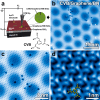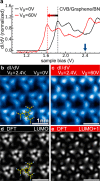Imaging and tuning molecular levels at the surface of a gated graphene device
- PMID: 24746016
- PMCID: PMC4070845
- DOI: 10.1021/nn501459v
Imaging and tuning molecular levels at the surface of a gated graphene device
Abstract
Gate-controlled tuning of the charge carrier density in graphene devices provides new opportunities to control the behavior of molecular adsorbates. We have used scanning tunneling microscopy (STM) and spectroscopy (STS) to show how the vibronic electronic levels of 1,3,5-tris(2,2-dicyanovinyl)benzene molecules adsorbed onto a graphene/BN/SiO2 device can be tuned via application of a backgate voltage. The molecules are observed to electronically decouple from the graphene layer, giving rise to well-resolved vibronic states in dI/dV spectroscopy at the single-molecule level. Density functional theory (DFT) and many-body spectral function calculations show that these states arise from molecular orbitals coupled strongly to carbon-hydrogen rocking modes. Application of a back-gate voltage allows switching between different electronic states of the molecules for fixed sample bias.
Figures



References
-
- Schedin F.; Geim A. K.; Morozov S. V.; Hill E. W.; Blake P.; Katsnelson M. I.; Novoselov K. S. Detection of Individual Gas Molecules Adsorbed on Graphene. Nat. Mater. 2007, 6, 652–655. - PubMed
-
- Sojoudi H.; Baltazar J.; Tolbert L. M.; Henderson C. L.; Graham S. Creating Graphene P–N Junctions Using Self-Assembled Monolayers. ACS Appl. Mater. Interfaces 2012, 4, 4781–4786. - PubMed
-
- Peimyoo N.; Li J.; Shang J.; Shen X.; Qiu C.; Xie L.; Huang W.; Yu T. Photocontrolled Molecular Structural Transition and Doping in Graphene. ACS Nano 2012, 6, 8878–8886. - PubMed
-
- Lee B.; Chen Y.; Duerr F.; Mastrogiovanni D.; Garfunkel E.; Andrei E. Y.; Podzorov V. Modification of Electronic Properties of Graphene with Self-Assembled Monolayers. Nano Lett. 2010, 10, 2427–2432. - PubMed
-
- Kim M.; Safron N. S.; Huang C.; Arnold M. S.; Gopalan P. Light-Driven Reversible Modulation of Doping in Graphene. Nano Lett. 2012, 12, 182–187. - PubMed
Publication types
LinkOut - more resources
Full Text Sources
Other Literature Sources
Molecular Biology Databases

